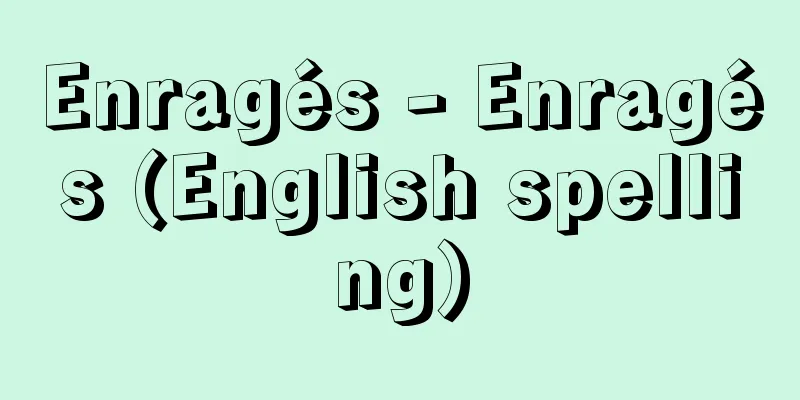Renju

|
It is commonly known as "Gomoku Narabe", and is also called Gocho Narabe, Goren, and Gotsu Ishi. Modern Rengo established and refined the rules and gameplay of "Gomoku Narabe". Traditionally, the oldest historical document for Rengo was a passage in the "Book of Han" (2nd century BC) that reads, "Wang Wang Shou, a man of Gan and Zhao, was a young man who was called to the Imperial Court to play Kakugo. " The Kakugo mentioned here was Gomoku, and it was believed to have been introduced to Japan during the Nara period. Furthermore, the oldest historical document in Japan states that "In the third year of the reign of Empress Jito (689), Sugoroku was banned, and this game became popular" (published in 1922 by Yabugami Masami). However, the Nihon Shoki only mentions "forbidden Sugoroku," and there is no mention of "the game of Sugoroku became popular," so it appears to have been written based on inference. According to recent research and studies, it is said that it was born as a side skill to Go and was established by the 10th Kuwanaya Buemon (?-1801), a merchant who had business with the Nijo family in Kyoto and lived in Matsubara Yanagi-Baba. It was called "Gotsu-Koku" in the Kuwana family and was passed down through the generations of the family. The oldest renju book is the "Gotsu-Koku Josekishu" (Collection of Rules for Playing Goseki), published twice (1856) by the 13th Buemon (1831-1900). Doi Goga (1817-80), a Chinese scholar from the Tsu domain during the Ansei era (1854-60), was passionate about this technique and wrote Kakugo Shinpu in 1858 (Ansei 5). In the preface, he wrote, "The Kakugo that appears in Chinese classics is probably the Gomoku game we play, so I have named the Gomoku game we play Kakugo." This led to the misunderstanding that Gomoku was the same as Kakugo. The name Renju (called Renju at the time) was first coined in 1899 (Meiji 32) when Kuroiwa Ruiko (pen name Takayama Goraku, first Meijin) announced it in the newspaper Yorozu Choho at the time, and the Tokyo Renjusha was founded in 1906. Currently, the Japan Renjusha Association is an incorporated association that holds the Meijin Tournament (46th as of 2008) and various other tournaments, publishes the monthly Renju World, certifies ranks, promotes international play, and engages in other activities. The rules of Renju have undergone many changes before being unified into the rules described below, but discussions of the rules began as early as the end of the Edo period. Today, Gomoku is known to be popular in countries around the world, but this is thought to be because Japanese diplomats, trading company employees, travelers, and others enjoyed the game as a pastime at the time, and it naturally took root. The names of Gomoku vary in each country, such as Rufaczak in Sweden, Morpion in France, Krestiki-Noriki in Russia, Amoeba in Hungary, Wutchi in China, Omoku in Korea, Pente in the United States, and Gomoku in Denmark. Many of these have transitioned to the name "Renju". In December 1982, the "Swedish International Renju Tournament" was held in Sweden, and the "Japan-Switzerland Friendship Renju Tournament" was held in Hakone and Kyoto in July of the following year, and exchanges continued until 1988. In April 1983, a "National Renju Tournament" (postal match) was held between three teams (four players per team) from Japan, the Soviet Union, and Sweden. In August 1988, the Renju International Federation (abbreviated RIF, headquartered in Sweden) was established by the four countries of Japan, Sweden, the Soviet Union, and the Netherlands. The current member countries are 14 countries and regions: Japan, Sweden, Finland, the Czech Republic, China, South Korea, Canada, and the former Soviet Union countries of Russia, Estonia, Armenia, Ukraine, Uzbekistan, Azerbaijan, and Taiwan. RENJU WORLD, published by RIF, is read in 35 countries. The 1st Renju World Championship was held in August 1989 in Kyoto, said to be the birthplace of Renju, and since then it has been held every two years in various places such as the Soviet Union (held in 1991, shortly after which the Soviet Union collapsed), Sweden, Estonia, Russia and China, and in 2007 it was held in Tyumen, Russia. Furthermore, the Youth World Championship and Team World Championship have been held every two years since 1996, and the Women's World Championship since 1997. International games over the Internet have also become popular, with games across borders becoming commonplace. [Yoshimi Hayakawa] Game rules and competition methodThe rules of Rengo are properly called Shuki and are as follows: (1) The game board is a special one with 15 lines each, and black and white stones are used. (2) Black plays first, and players take turns playing from the center of the board. The first player to create a "five in a row" vertically, horizontally, or diagonally wins. (3) Black is prohibited from playing "three three," "four two," or "long consecutive moves" before reaching "five consecutive moves" (forbidden moves), and if he violates this rule, he will lose. However, when White plays a forbidden move, he must announce it to Black. If White fails to do so and makes his next move, Black's forbidden move is lifted and the game continues. (4) White has no prohibited moves, and a long streak of moves by White results in a win. (5) White 6 and subsequent moves can be abandoned. (6) A draw occurs when: (a) one player proposes a draw and the other player accepts it, or (b) both black and white players abandon consecutive moves. The competition method is decided by the organizers for each rank and tournament, but generally consists of the following three types. (1) Free play: This is a method of playing in which there are no restrictions on either the first or second player other than the rules. (2) Alternating bead patterns There are 26 basic bead patterns for how black plays up to 3, and black (provisional first) chooses from these and arranges them up to 3. After this, white (provisional second) can choose to keep the white or take the black. This determines black and white, and white plays alternately from white 4 onwards. This is an attempt to maintain a balance between first and second by restricting how black plays. (3) Five beads, two questions This is a style of play mainly used by advanced players who play first. Up to black 3, the player plays by alternating bead patterns, and the next white 4 is free. Black 5 indicates two places where he wants to play, and white chooses one and plays. Currently, all official games, including Meijin matches and world championship matches, both at home and abroad, are played by alternating bead patterns and five beads, two questions. [Yoshimi Hayakawa] "Introduction to Renju (Gomoku Narabe)" by Hayakawa Yoshimi (1977, Takahashi Shoten)" ▽ "A sure-fire way to win at Renju" by Sakata Goro (1977, Takahashi Shoten)" ▽ "An Introduction to How to Win at Renju" by Sakata Goro (1984, Nihon Bungeisha)" ▽ "The Renju Game: A General Guide to Hitting Five Beads in Two Places" by Saito Shuichi (1994, Self-published)" ▽ "Renju" by Sakata Goro (1996, Mainichi Communications)" ▽ "A sure-fire way to win at Renju: Winning in Two Moves" by Nishimura Toshio (2000, Kumamoto Nichinichi Shimbun Information and Culture Center)" [Reference] |©Shogakukan "> Various Shapes of Renju ©Shogakukan "> Basic bead shapes for Renju (reference chart and names) Source: Shogakukan Encyclopedia Nipponica About Encyclopedia Nipponica Information | Legend |
|
一般には「五目並べ」として親しまれ、五丁並べ、五連(ごれん)、五つ石、ともいわれていた。「五目並べ」にルールと対局手合いを確立し整備したのが近代連珠である。 従来、連珠の最古の史料とされていたのは『漢書(かんじょ)』(紀元前2世紀)に記載されている「吾丘寿王字子贛趙(こうちょう)人也、年少以善格五召待詔」の一節で、ここにいう格五(かくご)が五目並べのことであり、奈良時代に日本に伝わったとされていた。 また、日本における最古の史料は、「持統(じとう)天皇の三年(689)、双六(すごろく)の禁ぜらるるや此(こ)の技の流行を致(いた)せるなり」(1922、藪上昌美(やぶがみまさみ)発表)といわれていたが、『日本書紀』によると「禁断双六」とあるだけで、「格五の技流行を致せるなり」に該当するところはまったくなく、推察によって記述されたとみられる。 最近の調査・研究によると、囲碁の余技として生まれ、これが、京都・二条家出入り商人で松原柳馬場に住んだ鬢付(びんつけ)油商、第10代桑名屋武右衛門(ぶえもん)(?―1801)によって確立されたといわれる。桑名家では「五つ石」と称されており、同家では代々打ち継がれ、第13代武右衛門(1831―1900)が著した『五石定蹟集(いつついしじょうせきしゅう)』2刊(1856)が最古の連珠書として現存している。 なお、安政(あんせい)年間(1854~60)の津藩の漢学者、土井聱牙(ごうが)(1817―80)はこの技に熱中し、1858年(安政5)に『格伍新譜』を著しているが、この序文によると、「漢書に現れる格五は我々のやっている五目並べであろうと思われるので、我々のたしなんでいる五目並べを格五と命名する」と記している。これによって、その後、五目並べ=格五と誤解されていった。 連珠(当時は聯珠(れんじゅ))と命名されたのは1899年(明治32)で、黒岩涙香(るいこう)(号は高山互楽・第一世名人)が当時の新聞『萬朝報(よろずちょうほう)』に発表したのが始まりで、1906年東京聯珠社が創立された。現在は、社団法人日本連珠社が名人戦(2008年現在、第46期)や各種の棋戦を実施し、月刊『連珠世界』の発行、段位の認定、国際普及その他の活動を行っている。 連珠のルールは、幾多の変遷を経て、後述のルールに一本化されているが、このようなルールの論議は、すでに幕末のころから始まっていた。現在、世界各国で五目並べが親しまれていることが確認されているが、これは日本人外交官や商社マン、旅行者などが、その時々の慰みに興じたものが、自然に定着したものと考えられる。 各国の五目並べの呼び名はまちまちで、スウェーデンではルファチャック、フランスではモーピオン、ロシアではクレスチキ・ノーリキ、ハンガリーではアメーバー、中国では五子棋(ウーツーチ)、韓国では五目(オモク)、アメリカではペンテ、そして、デンマークでは日本名のゴモクである。これらの多くが「連珠」の呼び名に移行している。1982年12月スウェーデンで「スウェーデン国際連珠大会」、翌年7月「日ス親善連珠大会」が箱根と京都で催され、交換交流は88年まで続いた。また、1983年4月から、日本、ソ連、スウェーデンの各国3チーム(1チーム4名)による「国別連珠対抗戦」(郵便対局)が実施された。1988年8月に、日本、スウェーデン、ソ連、オランダの4か国で連珠国際連盟(略称RIF、本部スウェーデン)が設立された。現在の加盟国は、日本、スウェーデン、フィンランド、チェコ、中国、韓国、カナダと、旧ソ連を構成していたロシア、エストニア、アルメニア、ウクライナ、ウズベキスタン、アゼルバイジャン、および台湾の14の国と地域で、RIFが発行する『RENJU WORLD』は35か国で愛読されている。 1989年8月、連珠発祥の地とされる京都で「第1回連珠世界選手権戦」が催され、以後2年ごとに、ソ連(1991年に開催、その直後にソ連が解体)、スウェーデン、エストニア、ロシア、中国などの各地で開催され、2007年はロシアのチュメニで開催された。また1996年から「ユース世界選手権」「チーム世界選手権」、97年から「女流世界選手権」がそれぞれ2年ごとに催されている。また、インターネットによる国際対局が盛んに行われるようになり、国境を越えた対局が日常的に繰り広げられている。 [早川嘉美] 対局ルール・競技方法連珠のルールは正しくは珠規(しゅき)とよばれ、次のとおりである。 (1)競技盤は、縦、横それぞれ15本の専用の盤を用い、石は黒と白を使用する。 (2)黒を先手とし、盤の中央より交互に打ち、黒、白どちらかが、縦、横、斜めのいずれかに、先に「五連」をつくったほうを勝ちとする。 (3)黒は「五連」になるまでに「三々」「四々」「長連」を打つことを禁じ(禁手)、これを犯したときは負けとする。ただし、白は、黒が禁手を打ったときは黒に宣言しなければならず、これを怠り、次の着手をしたときは、黒の禁手は解消され、競技は続行する。 (4)白にはいっさいの禁手がなく、白の「長連」は白勝ちとする。 (5)白6以降の着手は放棄することができる。 (6)引き分けの成立は次のとおりとする。(a)どちらか一方が引き分けを提案し、相手がこれを受け入れたとき。(b)黒白が連続して着手を放棄したとき。 競技方法は、段級位や大会ごとに主催者が決定するが、おおむね次の3種から構成されている。 (1)自由打ち 先手も後手も珠規以外になんの制限もなく、競技する方法である。 (2)珠型交替打ち 黒3までの打ち方に26種の基本珠型を定め、このなかから黒(仮先)が選んで3までを並べる。このあと白(仮後)がそのまま白をもつか、黒をとるか選ぶことができる。これで黒・白が確定し、白4から交互に打つ。これは黒の打ち出し方を制限することによって、先・後のバランスを保とうとしている。 (3)五珠二題打ち 主として有段者の先手に使われる打ち方で、黒3までについては珠型交替打ちにより打ち進め、次の白の4は自由。黒5は自己の打ちたいところ2か所を示し、白がどちらか一方を選択して打ち進める。現在の公式対局は、名人戦、世界選手権戦を含め、国内外を問わず、すべて「珠型交替、五珠二題打ち」で行われている。 [早川嘉美] 『早川嘉美著『連珠(五目ならべ)入門』(1977・高橋書店)』▽『坂田吾朗著『連珠必勝法』(1977・高橋書店)』▽『坂田吾朗著『連珠の勝ち方入門』(1984・日本文芸社)』▽『斉藤秀一著『連珠ゲーム 五珠二カ所打ち総論』(1994・自費出版)』▽『坂田吾朗著『連珠』(1996・毎日コミュニケーションズ)』▽『西村敏雄著『連珠必勝法 二手で勝つ』(2000・熊本日日新聞情報文化センター)』 [参照項目] |©Shogakukan"> 連珠のいろいろな形 ©Shogakukan"> 連珠の基本珠型(早見表と名称) 出典 小学館 日本大百科全書(ニッポニカ)日本大百科全書(ニッポニカ)について 情報 | 凡例 |
Recommend
Addition and subtraction
A method for solving simultaneous equations by mak...
Nomad - Yuudou
[Noun] (suru) To move freely. "In the pond......
Llanos, F.de (English spelling) LlanosFde
... The Middle Ages in Spain continued until the ...
mester de clerecía (English spelling) mesterdeclerecia
…This heroic poem of unknown authorship, with the...
Masanobu Okumura
An ukiyo-e artist from the mid-Edo period. He was...
Anatomy
…The majority of the population is Turkish, but t...
Oshin - Oshin
...The Danaan Giants (another name for the race o...
Dinodon orientalis (English spelling) Dinodon orientalis
… [Takahiro Matsui]. … *Some of the terms that me...
Glass Transition - Glass Transition
When metals, inorganic substances, organic substa...
Tribe - tribe
〘Noun〙① A clan. A family. A lineage that descends ...
WTBS
…Today, it has various contracts with television ...
Leningrad
…The second largest city in the Russian Federatio...
Lead minerals - Lead minerals
The most important mineral source of lead is galen...
Montague
British salon host. Born into a Yorkshire landowni...
Bluegrass State
…The state is hilly, and the Ohio River, which fl...









